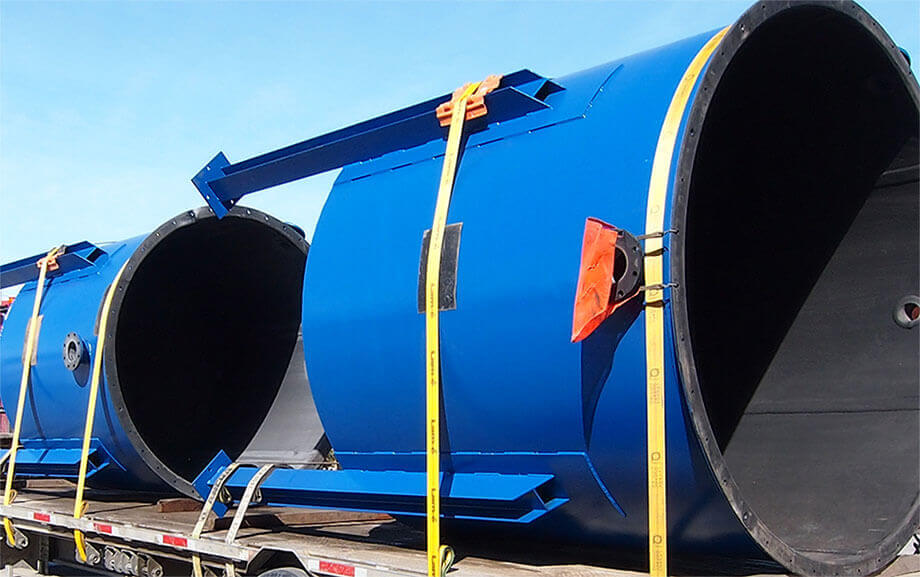Rubber tank lining
Élastomont has extensive expertise in tank lining (hot vulcanizing, cold vulcanizing, internal pressure cure or exhaust cure). Our team can offer turn-key projects to facilitate the implementation of a mandate. From your technical designs, from preparation of steel through the painting and final inspection, Élastomont will accompany you. Our quality system meets the standards of the engineering firms while providing tracking on manufactured parts. The installation can be done at the factory or directly on site.

List of coatings
Natural flexible rubber coating
The soft natural rubber coating provides good resistance to most inorganic chemicals except strong oxidizing agents. Rubber with exceptional abrasion resistance responds very well to thermal variations of metal, Example of use: mining, acid tank, HCL, chemical and food procedures (FDA) etc.
Pros:
- Not affected by cold or rapid temperature changes;
- Good general chemical resistance in limiting the temperature;
- Excellent against abrasion and tearing.
Cons:
- Not resistant to oil;
- Not flame resistant;
- Weak resistant to the ozone, sunlight, and weather;
- Limited to 120 °F (special stocks -150 °F).
Uses:
- Chemical storage tanks;
- Drops, agitators;
- Tumblers, vibrators, cyclones, fans, pumps, pipes and fittings, etc.
')Fiche technique Caoutchouch Naturel Souple
Semi-rigid Natural rubber ebonite coating
The semi-rigid natural rubber and hard rubber coating offers good resistance to many chemicals and has better heat resistance than the soft natural rubber. : Example of use: tanks, organic and inorganic acids, chlorine gas, plating and processing water, etc.
Pros:
- Excellent resistance to chemical permeation;
- Resistance to temperatures greater than 200 °F;
- Physically hard.
Cons:
- Not resistant to oil;
- Not flame resistant;
- Subject to damage from exposure to cold or sudden extreme temperature changes.
Fiche technique Caoutchouch Naturel Semi-rigide et ÃĐbonite
Triflex or tribond rubber coating
The triple layer (soft-hard - soft) rubber coating has excellent resistance to abrasions and chemicals. The central layer of semi-rigid rubber provides a non-permeable barrier and a flexible sub-pad allows for maximum grip in all forms of steel and the top layer is designed to provide maximum resistance to abrasion and chemical attacks. Example of use: steel pipe pickling, used acid tanks, etc.
Pros:
- Good flexibility and less danger of cracking due to cooling or temperature changes;
- Chemicals and resistance to greater penetration than soft rubber in limiting temperatures.
Cons:
- Not resistant to oil;
- Not flame resistant;
- Limited resistance to abrasion;
- Temperature limited to 180 °C.
Uses:
- Suitable for trailer tanks where bleach or caustic point loads can be handled (not constant);
- Pickling acid tanks where the enveloping block is used;
- Plating tanks (nickel, copper, cadmium), hard rubber is preferable.
Triflex or tribond rubber datasheet
Chlorobutyl rubber coating
The Chlorobutyl coating offer good resistance to acids and caustic solutions and superior resistance to the ozone. Not Affected by cold or rapid temperature changes. Example of use: phosphoric acid tank and sodium hypochlorite tank. Chlorobutyl is resistant to up to 200° F for most acids with heat.
Pros:
- Resistance to temperatures greater than 200 °F;
- Not affected by cold or rapid temperature changes;
- Good resistance to ozone, sunlight and aging;
- Good resistance to chemical permeation
Cons:
- Not resistant to oil;
- Not flame resistant.
Uses:
- For hydrofluoric acid storage and processing;
- Mixed acid waste;
- Storage and transportation tanks with sodium hypochlorite;
- Valves and other equipment either chemical and thermal with conditions requiring a special coating.
Chlorobutyl rubber datasheet
Neoprene rubber coating
The neoprene coating is a synthetic rubber base with characteristics similar to those of natural rubber's physical properties. With a higher resistance to heat, the ozone and oil than natural rubber. Other synthetic rubbers such as SBR and Bromobutyl are also available.
Pros:
- Oil-resistant;
- Resistance to temperatures greater than 200 °F;
- Not affected by cold or rapid temperature changes;
- Flame resistant, will not combust;
- Good chemical resistance;
- Very good resistance to the ozone, sunlight;
- Very good resistance to abrasion.
Cons:
- More expensive than rubber;
- More difficult to apply;
- Attach with solvents;
- Attach with kerosene and mineral oils.
Uses:
- Sodium storage and caustic transport tanks;
- Chemical processing and storage tanks;
- Tumbling barrels and vibrators;
- Agitators, pumps, fans, pipes and fittings, other equipment.
Neoprene rubber datasheet
Nitrile rubber coating
The nitrile coating offers good resistance to fats, oils, aliphatic hydrocarbons and other nonpolar solvents. Affected by rapid changes in temperature. Good heat resistance up to 390 °F.
Pros:
- Good resistance to oil, fuel and hydraulic fluids;
- Good abrasion resistance and tensile strength;
- Good low temperature properties;
- Heat resistant;
- Insensitive to rapid changes in temperature.
Cons:
- Very expensive;
- More difficult to apply;
- Low resistance to light and the ozone;
- Low resistance to highly polar solvents: acetone, MEK.
Uses:
- Fuel and oil handling hoses, tanks;
- Joints. Nitrile rubber datasheet
Hypalon rubber coating
The hypalon coating has good resistance to high concentrations of sulfuric acid, the ozone and abrasion.
Pros:
- Oil-resistant;
- Resistance to temperatures greater than 200 °F;
- Not affected by cold or rapid temperature changes;
- Flame resistant, will not combust;
- Excellent resistance to the ozone, sunlight and weathering;
- Excellent resistance to chemical permeation;
- Excellent resistance to abrasion.
Cons:
- Very expensive;
- Difficult to apply.
Uses:
- Chrome plating tanks;
- Strong sulfuric acid;
- Nitric and hydrofluoric acid (pickling of stainless steel solution).
Hypalon rubber datasheet